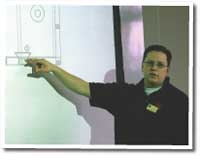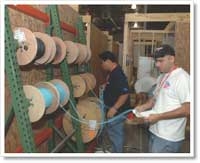CEDIA Installer Boot Camp: Making the Grade Page 3
 After the intros, Dave explained how the class would work. Every day would combine classroom time - guided by the 250-page course book we now owned - with hands-on work in the adjoining lab. The lab has 20 stations, each representing a miniature home. Developed by CEDIA, each of these clever little booths has one area with open studs and ceiling (to represent new construction) and another with sheetrocked walls and a closed ceiling (representing an existing home on which to practice retrofits). Day 1 would consist mostly of classroom time; Days 2 and 3 would focus much more on time in the lab. Wear grubby clothes, Dave warned us.
After the intros, Dave explained how the class would work. Every day would combine classroom time - guided by the 250-page course book we now owned - with hands-on work in the adjoining lab. The lab has 20 stations, each representing a miniature home. Developed by CEDIA, each of these clever little booths has one area with open studs and ceiling (to represent new construction) and another with sheetrocked walls and a closed ceiling (representing an existing home on which to practice retrofits). Day 1 would consist mostly of classroom time; Days 2 and 3 would focus much more on time in the lab. Wear grubby clothes, Dave warned us.
Before long, we were right in the thick of it, learning about the role of the entry-level technician on the job site and in his company's organization. The word "peon" comes to mind: Your goal as a new installer is to execute, perfectly and professionally, the design your shop developed based on the client's needs. But it's far from mindless labor. You need tons of skills, and throughout the job you're often called upon to make decisions based on common sense and solid technical judgment. Then there are all the things you need to not do to avoid creating problems that cost your employer money or make you unwelcome with other contractors on the site. That theme was repeated throughout our training: Think proactively as you do things to avoid having mistakes surface later, stay safe, and do no harm.
After spending some time on basic electrical concepts, we moved to a long discussion about . . . wire. Sure, it may sound dull as a doorknob to some folks, but if you're into custom installation, the subject of wire should really yank your cord, so to speak. Literally miles of cable go into some installs; as Grayson pointed out, "You can't do anything without it, so you need to know about it." Custom installers use many types, from various grades of coax to the Cat-5 "twisted pair" (or TP, as it's known) used for telephone and home networks, to the "16/2" and "16/4" TP used for most speaker runs (16 is the wire's thickness based on the American Wire Gauge standard; the second number refers to the number of conductors inside the sheathing).
 We were taught lots of arcane but critical details: How many enthusiasts know, for example, that Cat-5e cable has a maximum pull-tension of 25 pounds and a max bend radius no tighter than 1 inch? Exceed either spec during installation and you can greatly decrease cable performance, possibly wreaking havoc that will be costly to track down and repair later. And that's the point - Boot Camp was chock full of tidbits like this to keep us out of trouble and improve our efficiency.
We were taught lots of arcane but critical details: How many enthusiasts know, for example, that Cat-5e cable has a maximum pull-tension of 25 pounds and a max bend radius no tighter than 1 inch? Exceed either spec during installation and you can greatly decrease cable performance, possibly wreaking havoc that will be costly to track down and repair later. And that's the point - Boot Camp was chock full of tidbits like this to keep us out of trouble and improve our efficiency.
After lunch (CEDIA feeds you every day, God bless 'em), we learned about the industry-standard structured-wiring layout, in which nearly every cable makes a "home run" back to a central, stud-mounted distribution center. Then it was finally time for lab exercises.




























































